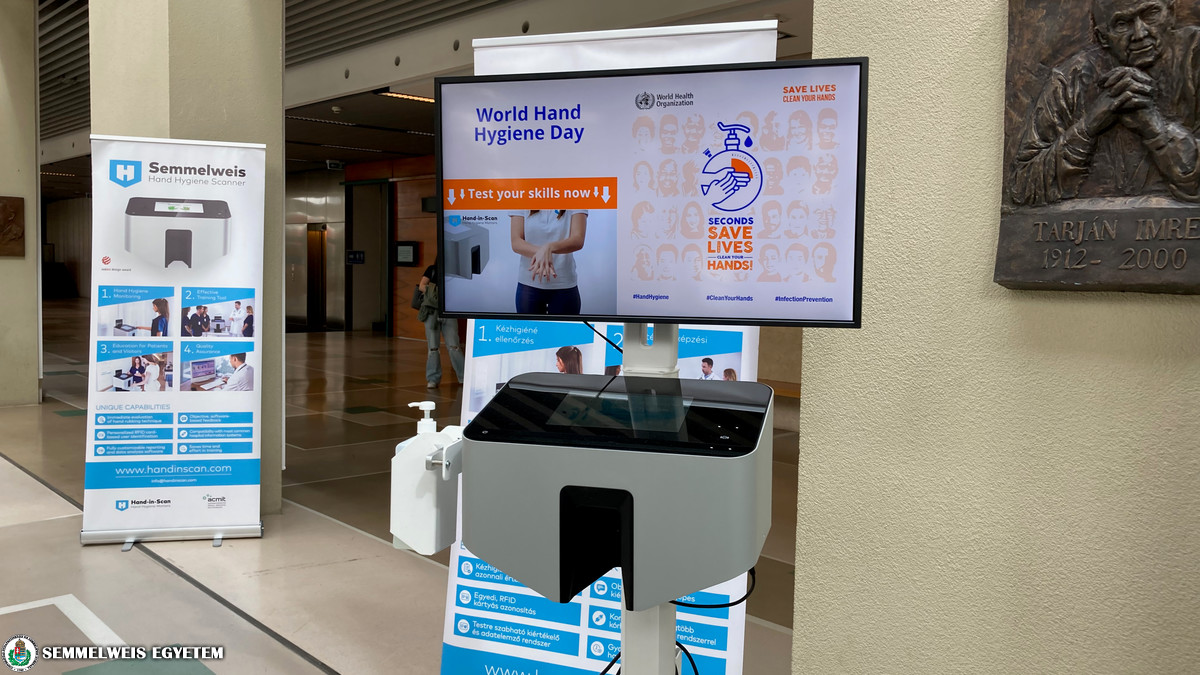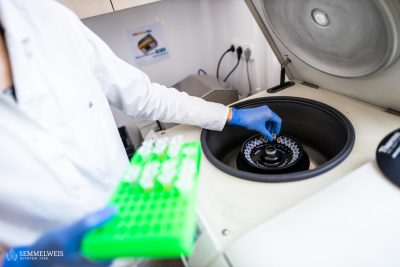The Clinical Center and the Faculty of Medicine have made the decision to acquire 7 Semmelweis Scanners. Four of them have already been installed at the departments of the faculty. The scanner (which is part of the Semmelweis Hand Hygiene System) uses advanced AI technology to correct hand hygiene technique and effectively educate the proper way of hand disinfection. This successful innovation has been developed by Semmelweis students and is now used worldwide.
Semmelweis Scanner is paired with a software based on artificial intelligence, which uses advanced photographic scanning technology to capture digital images of disinfected hands and provides immediate evaluation. The result is then displayed on the screen, showing a percentage of the disinfected and missed areas of the user’s hands – these results can significantly improve our hand hygiene routine. The data is sent to an analyzing system, where users can access their overall results and progress. The whole process of hand disinfection and assessment takes only about 40 seconds.
The Clinical Center of Semmelweis University and the Dean’s Office of the Faculty of Medicine have decided to purchase 7 Semmelweis Scanners in order to ensure the highest standards of hand hygiene practices. Four of the Semmelweis Scanners have already been set up under the coordination of the Department of Hospital Hygiene. The four Semmelweis Scanners can be found at the following locations:
- Semmelweis Basic Medical Science Center (EOK)
- Heart and Vascular Center
- Department of Pediatrics
- Department of Internal Medicine and Hematology
The scanner near the main entrance of the Basic Medical Science Center is set in visitor mode, available to anyone without an identification card.
We expect Semmelweis Scanners to ensure a high standard of hand hygiene across all staff of Semmelweis University. Students have the opportunity to use the scanner starting from their first year of studies. The possibility of a continuous feedback helps them reinforce proper hand hygiene habits.
– said dr. Katalin Antmann, head of Department of Hospital Hygiene.
Using the scanner, the staff of Semmelweis University can get a feedback on the effectiveness of their hand hygiene practice. First year students can start using the device during their practical courses in Nursing, while second year students can get a glimpse into the details of the machine’s artificial intelligence – added dr. Antmann.
“The Semmelweis Hand Hygiene System is used in 50 Hungarian institutions and in 400 hospitals and healthcare institutions of more than 30 countries (Italy, Hong Kong, South Korea) worldwide”, said Tamás Haidegger, founder and head of HandInScan Zrt, the company that developed the system.
He also added that he and the other founders of the company obtained their degree in biomedical engineering of the joint program between Semmelweis University and Budapest University of Technology and Economics. Their biomedical studies helped them to develop the medical device.
The aim of the Semmelweis Scanners is to accompany students in their medical career. The device will be introduced on the first day of their university studies and will help them to learn the proper way of handwashing and hand disinfecting. Later, as residents they can use the device to measure their hand hygiene routine.
“The Semmelweis Scanner and its system can be considered the 21st century implementation of Ignác Semmelweis’ hand hygiene practice”, added Gyula Vértesy, consultant of HandInScan, and program manager of Semmelweis University.
The device’s unique system has been proved exceptional on many occasions. It has been awarded with an IF Gold award in 2020 and two Red Dot distinctions, the first in 2015 and the second in 2020 in the “service design” category.
Adam Szabo
Photo: Attila Kovács-Semmelweis University
Translation: Norbert Lukács


